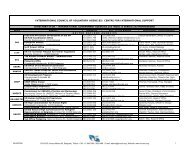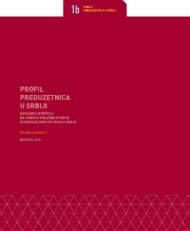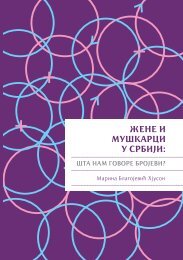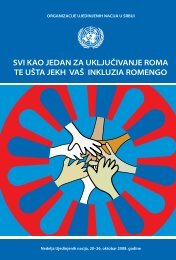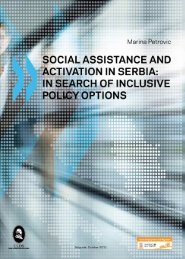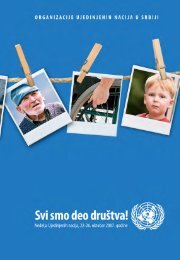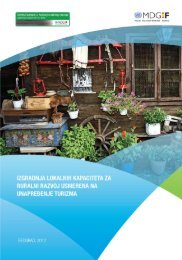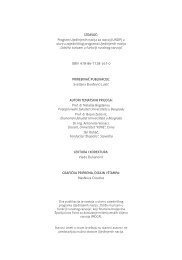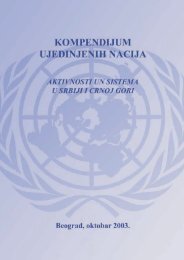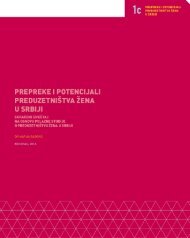Ethnic distance - United Nations in Serbia
Ethnic distance - United Nations in Serbia
Ethnic distance - United Nations in Serbia
You also want an ePaper? Increase the reach of your titles
YUMPU automatically turns print PDFs into web optimized ePapers that Google loves.
<strong>Ethnic</strong> <strong>distance</strong> and ethnic and gender<br />
stereotypes of<br />
youth <strong>in</strong> south <strong>Serbia</strong><br />
(<strong>in</strong> Vranje, Preševo and Bujanovac)
• This survey is conducted with<strong>in</strong> the project<br />
“1,2,3” to <strong>in</strong>form capacity development needs<br />
of young people <strong>in</strong> Vranje, Bujanovac and<br />
Presevo<br />
• Project is implemented by CSO NEXUS-Vranje<br />
• Project is funded by PBILD <strong>in</strong> amount of 2,738<br />
USD<br />
• Survey conducted <strong>in</strong> September 2011 <strong>in</strong><br />
Vranje, Bujanovac and Preševo<br />
2
GOALS OF SURVEY<br />
• To get the clear picture of ethnic <strong>distance</strong> of youth of<br />
<strong>Serbia</strong>n, Albanian and Roma nationality <strong>in</strong> south <strong>Serbia</strong><br />
(<strong>in</strong> Vranje, Preševo and Bujanovac)<br />
• Heterostereotypes (and autostereotypes) about<br />
representatives of <strong>Serbia</strong>n, Roma and Albanian<br />
nationality<br />
• Heterostereotypes about women <strong>in</strong> these three<br />
communities.<br />
3
Where is this survey conducted<br />
Vranje:<br />
High school of economy<br />
High school of medic<strong>in</strong>e<br />
High school of chemistry<br />
Gornja Čarsija settlement<br />
Bujanovac:<br />
High school "Sveti Sava“<br />
High school "Sezai Suroi“<br />
Južna Morava settlement<br />
Preševo:<br />
Technical school<br />
Gimnasium "Skenderbeu"<br />
“Železnička stanica”<br />
settlement<br />
4
SAMPLE<br />
• The study <strong>in</strong>cluded 224 young people, aged 17-<br />
18, of <strong>Serbia</strong>n, Albanian and Roma nationality.<br />
• Out of total number of respondents 50% were<br />
women<br />
5
• The sample <strong>in</strong> this study was 34% Serbs, 35%<br />
Roma and 31% Albanians, or<br />
• 33% Roma women, 36% <strong>Serbia</strong>n women and<br />
31% Albanian women<br />
6
<strong>Ethnic</strong> <strong>distance</strong><br />
• Measure of closeness or <strong>distance</strong> of the<br />
<strong>in</strong>dividual <strong>in</strong> relation to any ethnic group.<br />
• If the <strong>distance</strong> is greater, the more <strong>in</strong>fluence<br />
behaviour <strong>in</strong> the community, or the <strong>in</strong>ability of<br />
social communication and participation <strong>in</strong><br />
jo<strong>in</strong>t programmes that are <strong>in</strong>tended to<br />
improve general liv<strong>in</strong>g conditions<br />
7
Instrument for measur<strong>in</strong>g the <strong>distance</strong>: a modified Bogardus<br />
scale<br />
11 relations are measured:<br />
• To marry,<br />
• To be friend,<br />
• To be neighbor,<br />
• To be my chief,<br />
• To work <strong>in</strong> the same company,<br />
• To visit the same locations <strong>in</strong> the city,<br />
• To be equal <strong>in</strong> local self-government structures,<br />
• To manage <strong>in</strong> my Republic,<br />
• To have autonomy <strong>in</strong> my Republic,<br />
• To live permanently <strong>in</strong> my Republic,<br />
• I would exclude him/her from my Republic<br />
8
Results<br />
Ranks of rejection -Vranje, Bujanovac, Preševo<br />
Kriterijum I rang II rang III rang<br />
Da stupim u brak<br />
r a s<br />
Da budemo prijatelji/ce<br />
a r s<br />
Da mi bude komšija/nica<br />
a r s<br />
Da mi bude šef/ica<br />
a r s<br />
Da radimo u istoj firmi<br />
a r s<br />
Da izlazimo na ista mesta u gradu<br />
a s r<br />
Da budu ravnopravni/e u organima lokalne samouprave<br />
a r s<br />
Da rukovodi u mojoj Republici<br />
r a s<br />
Da imaju autonomiju u mojoj Republici a r s<br />
Da stalno živi u mojoj Republici<br />
Isključio bih ga/je iz moje Republike<br />
9<br />
a r s<br />
a r s
• The table shows that the first rank mostly have<br />
Albanians (9 out of 11) which means that they would<br />
be the rarest one for <strong>in</strong>teraction<br />
• Second rank mostly have Roma but there is lesser<br />
rejection than Albanians<br />
• Serbs are mostly accepted (10 out of 11 criteria) and<br />
they have third rank.<br />
10
• The nations reject each other mostly <strong>in</strong> supervisional<br />
relations specially <strong>in</strong> higher level (<strong>in</strong> Republic) and <strong>in</strong><br />
relations that imply higher level of <strong>in</strong>timacy, like<br />
marriage<br />
• To allow members of “other” nationalities to decide<br />
<strong>in</strong> “our” country about “our” staff and to allow them<br />
to <strong>in</strong>dependently run some part of it is equally<br />
unacceptable for all nationalities.<br />
11
• None of three ethnic groups is will<strong>in</strong>g to see<br />
members of other ethnic groups <strong>in</strong> positions or <strong>in</strong><br />
roles with power<br />
• If they allow member of other ethnic group some<br />
privileged position that would mean to decrease the<br />
position of the ethnic group he/she belongs and to<br />
endanger it.<br />
• Relations of friendship exclude relations of<br />
subord<strong>in</strong>ate-superior relationship, exclude someone<br />
dom<strong>in</strong>ation and encourage exchange and equality<br />
which mitigate sense of vulnerability and that is the<br />
reason why these relations are acceptable.
• There is a higher rank<strong>in</strong>g <strong>in</strong> ethnic <strong>distance</strong> of<br />
Serbs to Albanians and vice versa, while the<br />
<strong>distance</strong> of both sides to Roma is lesser.<br />
• <strong>Ethnic</strong> <strong>distance</strong> depends of place of liv<strong>in</strong>g.<br />
• So we have a case that <strong>in</strong> Vranje Albanians are<br />
more rejected than Roma.<br />
• Albanians are least rejected <strong>in</strong> Preševo and<br />
Roma <strong>in</strong> Bujanovac.<br />
13
• This result is <strong>in</strong> accordance with op<strong>in</strong>ion that<br />
attitudes that affect behaviour to other<br />
ethnic groups are rarely formed <strong>in</strong> direct<br />
relations to others and mostly by listen<strong>in</strong>g of<br />
such views and experience of others and<br />
mostly what political and social elite speak<br />
through media.<br />
• Considered <strong>in</strong> this way, ethnic <strong>distance</strong> is<br />
above all orchestrated by media<br />
representation of others.<br />
14
• Most rejected are Albanians, then Roma while Serbs<br />
are mostly accepted.<br />
• “Negative treatment” of Albanians is an expected<br />
consequence of years of conflict between them and<br />
Serbs which caused hostility, feel<strong>in</strong>gs of<br />
vulnerability and mistrust.<br />
• Roma as a group are completely marg<strong>in</strong>alized and<br />
great <strong>distance</strong> is manifested to this ethnicity<br />
although there is no reason for that <strong>in</strong> historical<br />
background, actual conflicts or territorial claims. It is<br />
very likely that racial prejudice are com<strong>in</strong>g from their<br />
differences (language, customs, appearance).<br />
15
Place of liv<strong>in</strong>g and<br />
<strong>distance</strong><br />
• Young people from Bujanovac are express<strong>in</strong>g<br />
smallest ethnic <strong>distance</strong>, than youth from<br />
Vranje while it is most pronounced among<br />
young people from Presevo.<br />
• Citizens of Presevo have maximum <strong>distance</strong><br />
to Serbs,<br />
• Citizens of Vranje have maximum <strong>distance</strong> to<br />
Albanians (although they have the least direct<br />
contact<br />
• Citizens of Presevo have maximum <strong>distance</strong> to<br />
Roma. 16
Place of liv<strong>in</strong>g and<br />
<strong>distance</strong><br />
• This f<strong>in</strong>d<strong>in</strong>g can po<strong>in</strong>t two th<strong>in</strong>gs:<br />
1. Prejudices are much stronger to the group<br />
that is objectively unknown so <strong>in</strong> Vranje is<br />
the greatest <strong>distance</strong> to Albanians although<br />
there are almost no Albanians <strong>in</strong> Vranje,<br />
2. Distance is the smallest <strong>in</strong> the communities<br />
whereas is perceptually almost equal<br />
representation of these three ethnicities<br />
(Bujanovac)<br />
17
Gender and<br />
<strong>distance</strong><br />
• Gender doesn’t affect <strong>distance</strong> particularly but<br />
women are less <strong>distance</strong>d than men. (M<strong>in</strong>imum<br />
<strong>distance</strong> is showed by women from Vranje, than<br />
Bujanovac and Presevo)<br />
• M<strong>in</strong>imum <strong>distance</strong> with<strong>in</strong> men is shown by male<br />
from Bujanovac<br />
• Maximum <strong>distance</strong> is shown by Albanians, than<br />
Serbs and the smallest is shown by Roma. The<br />
greatest <strong>distance</strong> is shown <strong>in</strong> Presevo and the<br />
smallest <strong>in</strong> Vranje<br />
18
STEREOTYPES<br />
• Features which members of one ethnic group<br />
attribute to members of other ethnic groups<br />
(heterostereotypes) or their<br />
(autostereotypes) and not <strong>in</strong>dividually but<br />
because they are members of groups for<br />
which the features are assume<br />
• Some stereotypes are very dissem<strong>in</strong>ated and<br />
there is great degree of agreement between<br />
the young people that the certa<strong>in</strong><br />
characteristic describes members of some<br />
ethnic group.<br />
19
Heterostereotypes<br />
about Albanians<br />
obta<strong>in</strong>ed on the whole sample<br />
Results <strong>in</strong> %<br />
Aggressive 50<br />
Insolent 44<br />
Hate others 42<br />
Pretty 41<br />
Culture 37<br />
Evil 33<br />
Like to rule 33<br />
Intelligent 32<br />
Cold 32<br />
Warm-hearted 32<br />
20
Heterostereotypes<br />
about Serbs<br />
obta<strong>in</strong>ed on the whole sample<br />
Results <strong>in</strong> %<br />
Tolerant 53<br />
Proud 51<br />
Friendly 50<br />
Evil 48<br />
Retarded 42<br />
Pretty 41<br />
Temperament 41<br />
Rough 40<br />
Intelligent 38<br />
Aggressive 38<br />
21
Heterostereotypes<br />
about Roma<br />
obta<strong>in</strong>ed on the whole sample<br />
Results <strong>in</strong> %<br />
Happy 53<br />
K<strong>in</strong>d-hearted 47<br />
Honest 38<br />
Hardwork<strong>in</strong>g 38<br />
Friendly 37<br />
Pretty 37<br />
Calm 37<br />
<strong>United</strong> 36<br />
Hospitable 32<br />
Dirty 31<br />
22
• The image of Albanians <strong>in</strong> Vranje, where there are almost<br />
no Albanians, is very negative<br />
• Roma have pretty negative image on Albanians and<br />
pretty positive image on Serbs<br />
• Image of Albanians and Serbs of Roma is not so negative<br />
but dom<strong>in</strong>ant features are describ<strong>in</strong>g them negatively<br />
• Albanians do not see Roma as someone who is threaten<br />
them as a nation but they see Serbs <strong>in</strong> that way<br />
23
• Serbs see Albanians as a nation that have<br />
tendencies to threaten other people and they are<br />
not will<strong>in</strong>g to see their positive features.<br />
• On the other side, although Albanians see Serbs<br />
<strong>in</strong> negative sense, they are still attribute them<br />
some positive features (culture, friendly,<br />
<strong>in</strong>telligent).<br />
• Both of them described other side as aggressive,<br />
those who like to rule, and hate the other.<br />
24
• Generally speak<strong>in</strong>g, slight tendency is noticed<br />
that Serbs describe other nations <strong>in</strong> negative<br />
sense more that other describes them.<br />
• In order to have positive op<strong>in</strong>ion about<br />
himself/herself, <strong>in</strong>dividual avoid bad op<strong>in</strong>ion<br />
about his/her group and tend to magnify its<br />
qualities. When there is division of groups it is<br />
almost always that own group is presented as<br />
better than other. That was evident this time,<br />
too.<br />
25To se pokazalo i ovog puta.
Autostereotypes<br />
of Albanians<br />
obta<strong>in</strong>ed on the whole sample<br />
Results <strong>in</strong> %<br />
Pretty 48<br />
Culture 45<br />
K<strong>in</strong>d-hearted 36<br />
Intelligent 33<br />
Tolerant 29<br />
Clean 28<br />
Hardwork<strong>in</strong>g 27<br />
Friendly 26<br />
Honest 23<br />
Reasonable 23<br />
26
Autostereotypes<br />
of Serbs<br />
obta<strong>in</strong>ed on the whole<br />
sample<br />
Results <strong>in</strong> %<br />
Pretty 53<br />
Intelligent 47<br />
Happy 43<br />
Hospitable 43<br />
Culture 41<br />
Friendly 41<br />
Hardwork<strong>in</strong>g 40<br />
Brave 40<br />
Warm-hearted 39<br />
Proud 36<br />
27
Autostereotypes<br />
of Roma<br />
obta<strong>in</strong>ed on the whole<br />
sample<br />
Results <strong>in</strong> %<br />
Happy 63<br />
Warm-hearted 53<br />
Honest 50<br />
Hardwork<strong>in</strong>g 50<br />
<strong>United</strong> 50<br />
Pretty 50<br />
Calm 47<br />
Brave 45<br />
Resourceful 44<br />
Hospitable 41<br />
28
• Heterostereotype of Serbs about Albanians is<br />
extremely negative and pretty widespread and<br />
autostereotype is pretty positive and also<br />
unified.<br />
• Autostereotype of Albanians is also pretty<br />
positive and unified and heterostereotype<br />
about Serbs pretty negative.<br />
29
• When one group starts to experience itself as<br />
the most correct, most moral, superior that,<br />
soon or later makes that group to draw<br />
boundaries between themselves and others.<br />
In limited group sense of vulnerability is<br />
always developed and that is the reason for<br />
<strong>in</strong>terruption of communication with <strong>in</strong>ferior<br />
and the group turns to isolation.<br />
30
Gender stereotypes<br />
• In many cultures, male features are<br />
traditionally valued as superior to female.<br />
These stereotypes are problematic s<strong>in</strong>ce they<br />
don’t consider real differences of gender and<br />
sexuality <strong>in</strong> human population.<br />
31
Gender stereotypes of<br />
women<br />
Results <strong>in</strong> %<br />
Pretty 89<br />
Nice 69<br />
Gentle 66<br />
Romantic 64<br />
Modern 63<br />
Honest 63<br />
Compassionate 63<br />
Hard-work<strong>in</strong>g 61<br />
Pleasant 58<br />
Tidy 57<br />
32
Gender stereotypes of<br />
men<br />
Results <strong>in</strong> %<br />
Likes sport 76<br />
Athletic 69<br />
Sociable 63<br />
Brave 63<br />
Determ<strong>in</strong>ed 58<br />
Funny 57<br />
Persistent 55<br />
Energetic 54<br />
Active 54<br />
Adventurous 54<br />
33
• Based on these results, we can conclude that<br />
there is a model that describes woman as<br />
modern, less patriarchal than was the case <strong>in</strong><br />
previous research: pretty, nice, modern,<br />
gentle, romantic etc.<br />
• This image of women is seen both from<br />
females and males.<br />
34
• In the stereotype of male role we can see one<br />
type, so called “sports-lov<strong>in</strong>g” type of person<br />
(he likes sport, athletic, friendly, brave etc.).<br />
• Culture stereotypes says that the desirable<br />
women behaviour is to be emotional, honest,<br />
hospitable, faithful, tidy. Mentioned features<br />
are not so expressed with our exam<strong>in</strong>ees so<br />
we can assume that the image of woman is<br />
slightly chang<strong>in</strong>g – from traditional to modern.<br />
35
• We can notice compatibility of image that<br />
women have about themselves and image<br />
that men have about women. This<br />
compatibility imposes the assumption that<br />
although image of women <strong>in</strong> this part of<br />
<strong>Serbia</strong> is slightly chang<strong>in</strong>g from the traditional<br />
to modern, it is still conditioned by social<br />
norms and depends on image that is imposed<br />
by patriarchal society.<br />
36
For more details, please refer to publication<br />
“<strong>Ethnic</strong> <strong>distance</strong> and ethnic and gender<br />
stereotypes<br />
of young people <strong>in</strong> South of <strong>Serbia</strong><br />
(<strong>in</strong> Vranje, Preševo and Bujanovac)”<br />
or<br />
nexusvranje@gmail.com<br />
www.nexusvranje.com<br />
37
This publication is created with the f<strong>in</strong>ancial<br />
support of PBILD.<br />
The f<strong>in</strong>d<strong>in</strong>gs and recommendations conta<strong>in</strong>ed <strong>in</strong><br />
this research are those of the CSO NEXUS—<br />
Vranje and do not necessarily reflect the<br />
position of the PBILD<br />
38
Thank you!<br />
39



